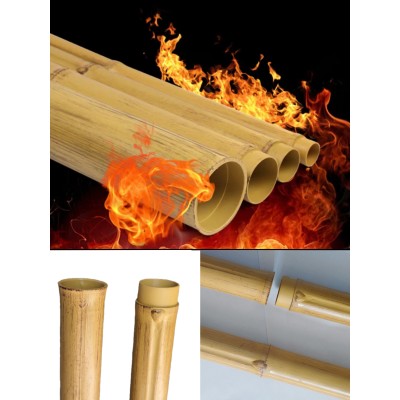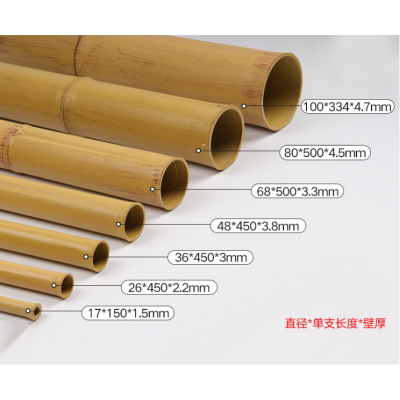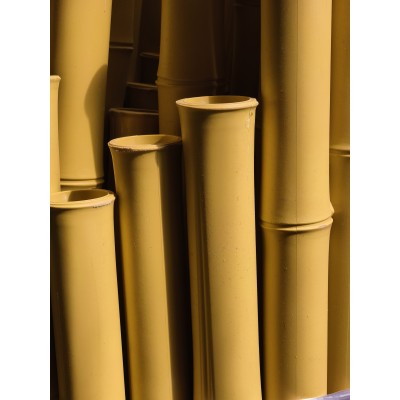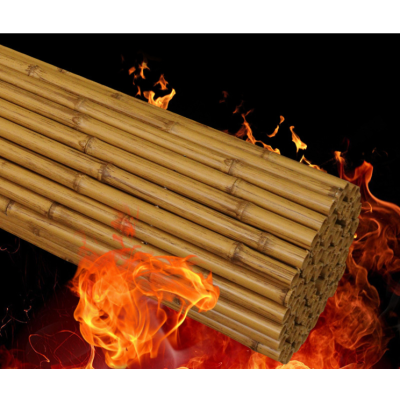Artificial bamboo poles have uniform looking, and the colors Bcould be customized according to your request. The faux bamboo canes could be assembled to fence too as per your request.
We offer a wide range of wholesale outdoor Artificial Bamboo Poles screening, available in various diameters, to enhance the aesthetic appeal of walls, ceilings, fences, gazebo, or palapa structures in parks and restaurants. These high-quality faux bamboo sticks create a stunning natural look that will impress your guests and create a welcoming atmosphere.
1. Features of artificial bamboo poles:
Materials:
HDPE, Nylon, and ASA
HDPE is best for both economic and weatherproof
Diameter:
15mm; 20mm; 26mm; 36mm; 48mm; 68mm; 80mm; 105mm
Length:
Could be made with designated length
UV-retardant
Fire retardant:
Available
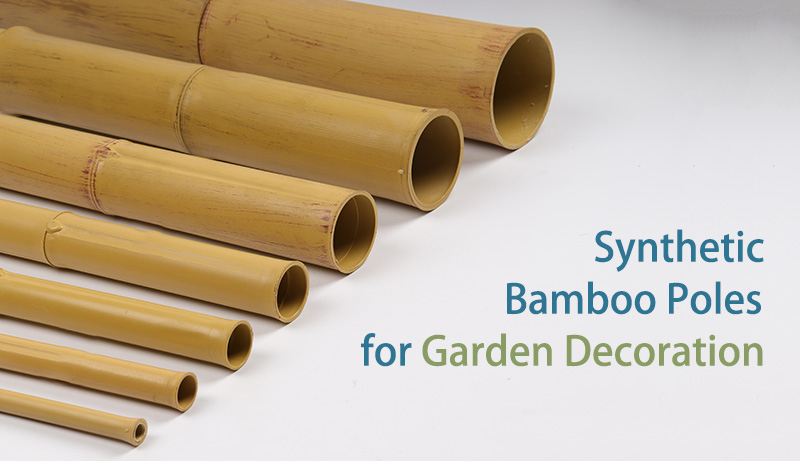
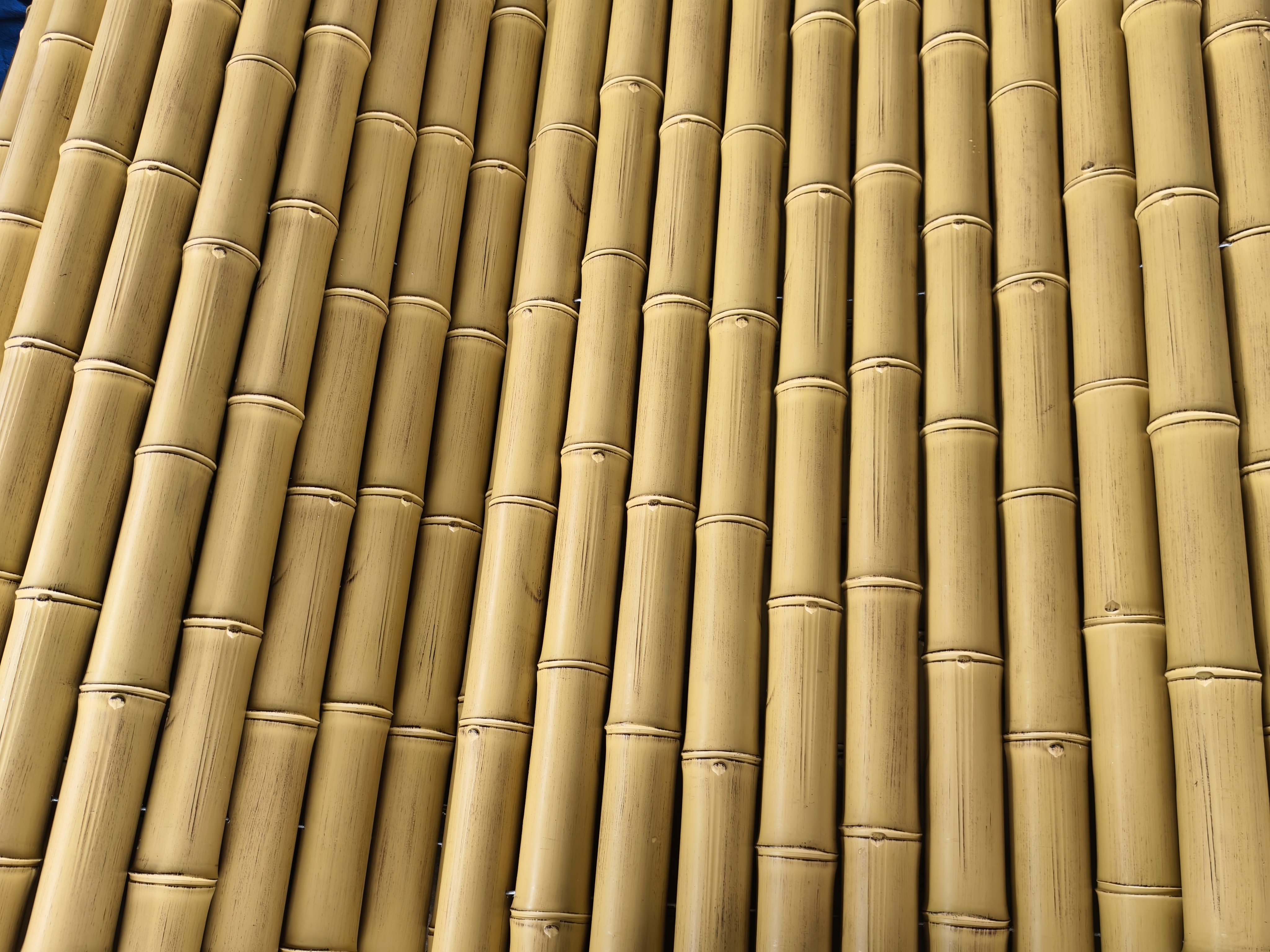
3. Advantages of fake bamboo sticks:
◭ Fire Retardant: Our Bamboo Pole has been rigorously tested and certified to meet class A fire-resistant standards.
◭ Weather Resistant: Designed to withstand the elements, our Bamboo Pole has undergone extensive weathering tests, demonstrating superior color-fastness even after 10000 hours of exposure.
◭ Mold and Pest Protection: Crafted from premium ASA resins, our artificial bamboo pole is engineered to be highly resistant to mold, rot, and insect damage, guaranteeing long-lasting durability.
◭ Non-Toxic: We prioritize sustainability and environmental responsibility. Our Bamboo Pole is 100% recyclable and free from polyvinyl chloride (PVC), making it a safe and eco-friendly choice.
4. Some F.A.Q. for our plastic bamboo poles:
◭ How is your fake bamboo fence pole products' quality?
● We have UV-proof equipment to test our materials.
● Only new materials are used.
● No recycled materials are used.
● Avoid PP materials.
● Put UV-proof additives and antioxidant materials during the production of materials.
◭ How to install your synthetic bamboo canes?
We have installation manual for our different types of artificial bamboo sticks.
Meanwhile, you could read our blog of the plastic bamboo poles installation.
5. Some other materials we could assist you to purchase:
◭ Artificial thatch roofing matetials
◭ Synthetic bamboo mat
◭ Wall decoration materials
◭ Floor decoration materials such as WPC timber
◭ Screws, nails or staples
◭ Some other fencing materials
Synthetic bamboo: The pole of the landscape, pleasant garden
Abstract: With the increasing diversification of modern landscape needs, synthetic bamboo has gradually emerged as a new material. This paper discusses the characteristics, application forms, advantages and challenges of synthetic bamboo in garden landscape construction, analyzes how it injects unique vitality into garden space, creates rich and diverse and sustainable landscape effects, and aims to provide new ideas and reference for the application of synthetic bamboo in garden design and construction.
I. Introduction
Landscape is an artistic expression of the integration of man and nature, in which traditional materials such as natural bamboo have long played a key role. However, faced with environmental changes, maintenance costs and many other factors, synthetic bamboo emerged. It not only retains some of the aesthetic characteristics of bamboo, but also overcomes some inherent defects of natural bamboo, and is gradually becoming an effective tool in the hands of landscape designers to shape smart landscape.
Second, the characteristics of synthetic bamboo
Material properties - Synthetic bamboo rod
Durability: The synthetic bamboo rod is usually made of polymer and fiber mixture, with strong corrosion resistance, anti-ultraviolet ability, compared with natural bamboo is not easy to decay, cracking, can maintain long-term structural integrity in the outdoor complex environment, greatly extend the service life, reduce the cost and resource consumption caused by frequent material replacement.
Stable physical performance: The density, strength and other indicators of the synthetic bamboo rod are optimized, which can withstand a certain amount of wind and pressure, and is not easy to deform, and can meet the needs of various structures such as garden decoration construction and fence construction, providing reliable support for landscape construction.
Aesthetic features - synthetic bamboo rod
High degree of imitation: Through advanced manufacturing technology, the color and texture of the synthetic bamboo pole are very close to the natural bamboo, from the warm light yellow to the deep turquoise green, the bamboo joints and bamboo leaves are clearly recognizable, and the natural beauty of bamboo is accurately reproduced and integrated into the garden scene without any sense of harmony.
Color and shape plasticity: In the production stage, color can be adjusted on demand to create unique color combinations, such as the dreamlike gradient color bamboo rod for creative landscape installations; It can also shape special-shaped sections according to the design mold, such as square and diamond-shaped bamboo poles, adding modern and novel visual elements to the garden.
Third, the application form of synthetic bamboo poles in gardens
Landscape construction - synthetic bamboo pole
Pavilions: With synthetic bamboo as the main frame material, Chinese or Japanese style leisure pavilions are built. Their light texture and transparent sense of space, combined with the surrounding flowers and green plants, create a quiet and elegant atmosphere for visitors to stop to enjoy the scenery and avoid the wind and rain, and become the visual focus and practical space node in the garden.
Covered Bridges: Construct covered Bridges across the water or connecting different areas. The winding synthetic bamboo bridge looks like a natural growth in the landscape of the garden, reflecting in the water, which not only guides the tour route, but also provides a unique viewing Angle. People walk on the bridge, like walking in the painting.
Garden sketches - synthetic bamboo poles
Flower stand: Designed into a variety of shapes, from simple single row type to complex dome type, wrapped vines and flowers, the support structure of the synthetic bamboo pole hidden under the flowers and green leaves, spring flowers, summer can shade the sun, add romantic and warm atmosphere to the garden, enhance the flower display effect.
Sculpture ornaments: The synthetic bamboo is processed into abstract or figurative sculpture forms, such as smart birds and silly animals, placed in the lawn and flowers, instantly activate the surrounding space, give the garden a lively and playful atmosphere, and become a highlight element to attract tourists to take photos and punch cards.
Fences and partitions
Boundary fence: The synthetic bamboo fence installed along the border of the garden is more amiable than the metal fence, and it is integrated with the natural environment, effectively dividing the space without destroying the overall sense of the garden, and its dense arrangement can also play a certain role in blocking and penetrating the landscape, ensuring the balance between privacy and appreciation.
Internal partition: Between the different functional areas in the garden, such as the quiet reading area and the lively children's play area, hollow or semi-transparent synthetic bamboo partition is set up, which can not only gently separate the space, but also do not hinder the sight communication and air circulation, and maintain the coherence and hierarchy of the garden space.
Fourth, the advantages of synthetic bamboo applications
Ecological sustainability
Resource saving: The production of synthetic bamboo rods does not need to cut down a large number of natural bamboo forests, reducing the pressure on original forest resources, and some synthetic materials can be recycled and reused, reducing the burden of waste on the environment, in line with the current circular economy concept, and helping the garden industry to transform to green development.
Low maintenance requirements: its weatherability eliminates frequent anti-corrosion and insect-proof treatment, saves manpower, material resources and the use of chemical agents, reduces the risk of pollution to soil and water, reduces the burden for daily garden maintenance, and allows maintenance personnel to devote more energy to landscape optimization rather than material maintenance.
Economic benefit
Controllable cost: Although the initial procurement cost of synthetic bamboo rod may be slightly higher than that of ordinary wood, taking into account its long service life and low maintenance cost, the overall cost is greatly reduced in the whole life cycle of garden projects, especially for the long-term operation of large-scale municipal gardens and commercial gardens, and the economic benefits are significant.
Convenient construction: The synthetic bamboo rod material is relatively light, the cutting and splicing operation is simple, no special construction equipment and highly skilled workers are required, the construction period is shortened, the on-site construction cost is reduced, the delivery speed of garden projects is accelerated, and the landscape benefits and economic returns are realized in advance.
V. Challenges and coping strategies
Cognitive limitations
Problem: The current landscape practitioners and the public do not know enough about synthetic bamboo, still used to choose traditional materials, worried about the environmental protection of synthetic materials, texture authenticity and other issues, limiting the promotion and application of synthetic bamboo.
Strategy: Strengthen popular science publicity, display the production process, performance advantages and actual case results of synthetic bamboo through garden exhibitions, academic forums, online popular science articles and other channels, invite professionals to explain and answer questions on site, and improve the recognition and acceptance of the industry inside and outside.
Technology optimization requirement
Problems: The performance of some synthetic bamboo rods fluctuates under extreme environment of high temperature and high cold, such as slight deformation after exposure to high temperature in summer and increased brittleness at low temperature in winter; And the surface color may fade after long-term use, affecting the appearance.
Strategy: Increase research and development investment, cooperate with material research institutions, improve the formula and manufacturing process, introduce high-temperature and cold-resistant additives, optimize the surface coating technology, improve the all-weather adaptability and long-term color retention of synthetic bamboo, and ensure long-term landscape stability.
Vi. Conclusion
With its unique advantages, the synthetic bamboo pole opens up a broad world in the field of garden landscape, from the pole to build a variety of landscape architecture, to stimulate the vitality of garden space, and bring people a pleasant garden experience. Despite the challenges, with the advancement of technology and deepening of cognition, it is expected to become one of the mainstream materials for future garden construction, helping to create more creative, ecological and economic feasibility of garden landscape, and achieve a more harmonious coexistence between man and nature in the urban environment.


